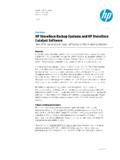Transcription of 2014 Taxicab Fact Book - Welcome to NYC.gov
1 2014 Taxicab fact BookThe Taxicab fact book was last published in 2006 by Schaller Consulting. Since then, many changes have occurred, allowing us to take a new look at how yellow taxis operate in New York City. The largest change has been the introduction of the Taxi Passenger Enhancement Program (TPEP), a technology initiative which introduced credit card readers to all taxis in 2008. Along with this came the collection of electronic trip-sheet data, replacing handwritten paper trip -sheets with independent records including information on pick-up and drop-off times and locations and itemized fare amounts. With the new TPEP data, we are able to take a look at taxi patterns from all taxis without having to rely on samples of 2014 Taxicab fact book is a quick look at the state of the yellow taxi industry (with a brief look at the other for-hire vehicle industries).
2 This will be the first in a regular summary of taxi trends in New York City. Not only does the 2014 fact book contain updated statistics on total trips and fares, but it also provides unique looks at trip patterns by borough, shifts and taxi availability, and driver and passenger (also known as Car Services or Community Cars)Provide for-hire service by pre-arrangementAround 500 base stations located throughout the five boroughsAbout 25,000 vehiclesVehicles must be affiliated with a baseAverage age of vehicles is about 7 yearsPassengers: about 500,000 per dayFare: set by base and varies by neighborhoodRegulationsTrip must be prearranged via basesStreet hailing not permittedWide variety of vehicle types (TLC inspection once every 2 years)Open entryBlack CarsProvide service mostly for corporate clients, setting fares by contracts with clientsAround 80 base stations located throughout the five boroughsAbout 10,000 vehiclesVehicles must be affiliated with a baseAverage age of vehicles is about yearsRegulationsPrearranged contracted service, 90% non-cash basisWide variety of vehicle types (TLC inspection once every 2 years)
3 Open entryOther IndustriesParatransitProvide transportation for healthcare facilitesAbout 2,000 vehiclesOver 200 paratransit providersLuxury LimousinesProvide chartered serviceAbout 7,000 vehiclesOver 200 companiesCommuter VansProvide service for passengers along fixed routesAbout 500 vehiclesAround 50 van authorizationsThere are 13,437 medallions, the right to run a yellow taxiA typical taxi travels 70,000 miles per year, enough to travel around the world timesThe average age of a taxi vehicle is years60% of taxi vehicles are hybrid-electric vehicles and 2% of taxi vehicles are wheelchair-accessibleThe are over 50,000 driversA typical driver shift is hoursPassengers.
4 600,000 per day | 236 MILLION per yearModels of OperationFleetsRun garages that own and operate many taxisDrivers lease the taxi on a daily or weekly basisThe lease fee is capped according to TLC regulationsDriver-Owned Vehicles (DOV)Driver conditionally owns the car but leases the medallion from an agent who manages it for an ownerIndividual Owner-OperatorsDriver owns car and medallion and is required to drive at least 210 shifts per yearRegulationsStreet hails or e-hails anywhere in NYCA ccessible vehicles are required to participate in Accessible Dispatch programTLC sets rate of fareSpecific vehicle standards (TLC inspection 3 times per year)Closed entry with a fixed supplyDrivers must be able to read, speak, and understand EnglishYELLOW TAXISBORO TAXISOTHER FOR HIRE VEHICLES (FHVs)Trips.
5 485,000 per day | 175 MILLION per yearBoro Taxis were created as a new class of license in 2012to provide legal, yellow-caliber taxi service to the boroughs,since 94% of yellow taxi pick-ups occur either in Manhattanor at one of the ,000 Boro Taxi permits are being issued in three groups of 6,000. The first group of 6,000 has been sold, with the second issuance planned for June Taxis are not permitted to pick up passengers in Manhattan below E 96th Street or W 110th Street or toserve airport taxi queuesBoro Taxis are a hybrid service, providing both street-hailand prearranged for-hire vehicle HailsAirport Taxi StandStreet HailsPrearrangedPrearrangedin Boro Zonein Boro ZoneJFKLGAWest 110 StreetEast 96 StreetBRONXMANHATTANQUEENSBROOKLYNSTATEN ISLANDBoro Taxi Service AreasAnywhereAnywhereFor more on medallions, see p 12 For more on drivers, see p 9-10 For more on shifts, see p 8 For more on passengers.
6 See p 11 For more on inspections, see p 13 For more on trips, see p 3-6 For more on yellow tripsby borough, see p 5-6 For more on inspections, see p 13 For more on inspections, see p 13 For more on Boro Taxis, including new factson a brand new service, check out the next Taxicab fact book !1 Liveries (also known as Car Services or Community Cars)Provide for-hire service by pre-arrangementAround 500 base stations located throughout the five boroughsAbout 25,000 vehiclesVehicles must be affiliated with a baseAverage age of vehicles is about 7 yearsPassengers: about 500,000 per dayFare: set by base and varies by neighborhoodRegulationsTrip must be prearranged via basesStreet hailing not permittedWide variety of vehicle types (TLC inspection once every 2 years)Open entryBlack CarsProvide service mostly for corporate clients, setting fares by contracts with clientsAround 80 base stations located throughout the five boroughsAbout 10,000 vehiclesVehicles must be affiliated with a baseAverage age of vehicles is about yearsRegulationsPrearranged contracted service, 90% non-cash basisWide variety of vehicle types (TLC inspection once every 2 years)
7 Open entryOther IndustriesParatransitProvide transportation for healthcare facilitesAbout 2,000 vehiclesOver 200 paratransit providersLuxury LimousinesProvide chartered serviceAbout 7,000 vehiclesOver 200 companiesCommuter VansProvide service for passengers along fixed routesAbout 500 vehiclesAround 50 van authorizationsThere are 13,437 medallions, the right to run a yellow taxiA typical taxi travels 70,000 miles per year, enough to travel around the world timesThe average age of a taxi vehicle is years60% of taxi vehicles are hybrid-electric vehicles and 2% of taxi vehicles are wheelchair-accessibleThe are over 50,000 driversA typical driver shift is hoursPassengers.
8 600,000 per day | 236 MILLION per yearModels of OperationFleetsRun garages that own and operate many taxisDrivers lease the taxi on a daily or weekly basisThe lease fee is capped according to TLC regulationsDriver-Owned Vehicles (DOV)Driver conditionally owns the car but leases the medallion from an agent who manages it for an ownerIndividual Owner-OperatorsDriver owns car and medallion and is required to drive at least 210 shifts per yearRegulationsStreet hails or e-hails anywhere in NYCA ccessible vehicles are required to participate in Accessible Dispatch programTLC sets rate of fareSpecific vehicle standards (TLC inspection 3 times per year)Closed entry with a fixed supplyDrivers must be able to read, speak, and understand EnglishYELLOW TAXISBORO TAXISOTHER FOR HIRE VEHICLES (FHVs)Trips.
9 485,000 per day | 175 MILLION per yearBoro Taxis were created as a new class of license in 2012to provide legal, yellow-caliber taxi service to the boroughs,since 94% of yellow taxi pick-ups occur either in Manhattanor at one of the ,000 Boro Taxi permits are being issued in three groups of 6,000. The first group of 6,000 has been sold, with the second issuance planned for June Taxis are not permitted to pick up passengers in Manhattan below E 96th Street or W 110th Street or toserve airport taxi queuesBoro Taxis are a hybrid service, providing both street-hailand prearranged for-hire vehicle HailsAirport Taxi StandStreet HailsPrearrangedPrearrangedin Boro Zonein Boro ZoneJFKLGAWest 110 StreetEast 96 StreetBRONXMANHATTANQUEENSBROOKLYNSTATEN ISLANDBoro Taxi Service AreasAnywhereAnywhereFor more on medallions, see p 12 For more on drivers, see p 9-10 For more on shifts, see p 8 For more on passengers.
10 See p 11 For more on inspections, see p 13 For more on trips, see p 3-6 For more on yellow tripsby borough, see p 5-6 For more on inspections, see p 13 For more on inspections, see p 13 For more on Boro Taxis, including new factson a brand new service, check out the next Taxicab fact book !22014 Taxicab fact Book10 0, 000200, 000300, 000400, 000500, 000600, 000700, 00020092011201020122013 JANFEBMARAPRMAYJUNJULAUGSEPOCTNOVDECJANF EBMARAPRMAYJUNJULAUGSEPOCTNOVDECJANFEBMA RAPRMAYJUNJULAUGSEPOCTNOVDECJANFEBMARAPR MAYJUNJULAUGSEPOCTNOVDECJANFEBMARAPRMAYJ UNJULAUGSEPOCTNOVDEC29,09272,019113,7945 93,094591,464597,327 JANFEBMARAPRMAYJUNJULAUGSEPOCTNOVDECDECJ ANFEBMARAPRMAYJUNJULAUGSEPOCTNOVDECJANFE BMARAPRMAYJUNJULAUGSEPOCTNOVDECJANFEBMAR APRMAYJUNJULAUGSEPOCTNOVDECJANFEBMARAPRM AYJUNJULAUGSEPOCTNOV20082009201020112012 2013 HIGHLOWMONTHS WITH HIGHEST & LOWEST AVERAGE DAILY TRIPSno dataAverage daily taxi usage is typically highest in the spring months and lowest in the summer monthsDays with fewer than 350.















